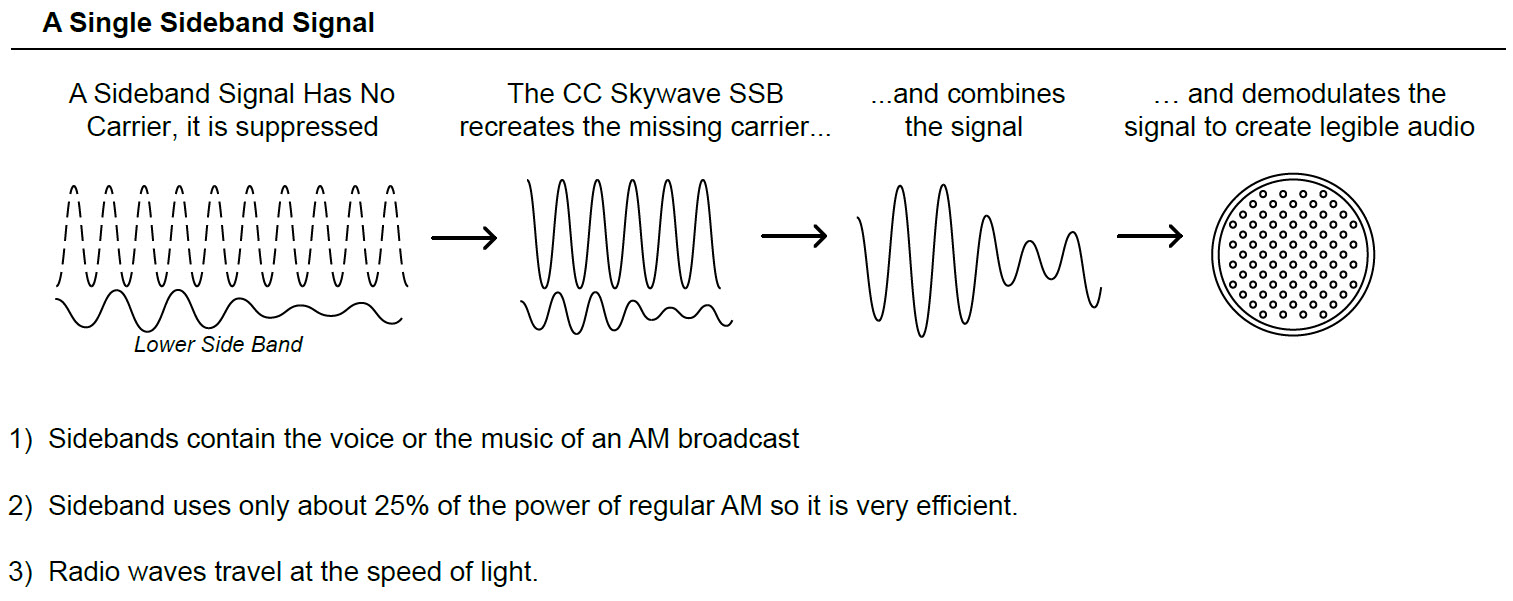What You Need to Know About SSB...
Different types of signals sent over radio waves are called MODES. SSB is a mode. AM is a mode. FM is a mode. CW (Continuous Waveform aka Morse Code) is a mode. RTTY (radio teletype) is a mode. And there are also many, many digital modes used to send text, pictures, telemetry and more over radio such as PSK31 and JT-65.
But wait, you say, "I thought 'AM' and 'FM' are bands." Indeed, these are the common names for the radio frequencies of 530-1700KHz (the "AM" band) and 88-108MHz (the "FM" band). As you have probably guessed already, these radio frequency bands got their names from the type or mode of broadcast signals that are transmitted.
The "AM" band uses AM mode (or Amplitude Modulation) and the "FM" band uses FM mode (or Frequency Modulation). "Modulation" is the term we use to describe how we take information (speech, music, digital signals, etc.) and join them with a radio frequency (RF) signal to send it where it needs to go on a given frequency.
It is possible to use ANY mode (AM, FM, SSB, CW, RTTY, DIGITAL) on ANY band or frequency. In actual practice, different modes work better on different bands. "FM" broadcasting takes up a lot of space in the radio spectrum (it's quite wide so that music can sound good), so it is located where there is lots of room for these wide-band frequencies on the VHF (very high frequency) band.
Yet More Brief Technical Facts About SSB


Without going too deep into the technical stuff, you may be interested to know that SSB actually came from the AM mode. It is about 1/4 of the AM signal (one of the TWO side-bands that make up an AM transmission), minus the "carrier" (the raw radio signal that "carries" the voice or other modulation). So, you get rid of one side-band along with the carrier and you have, single side-band!
It is also possible to receive many kinds of digital signals using the Skywave SSB. You can send the audio to your computer or other device for decoding with the appropriate software using a simple audio patch cable. The JT-65HF digital mode is particularly useful and popular because it can receive very weak signals very well. The original version of JT-65 was actually used by hams to make contacts by bouncing signals off the moon with minimal antennas and power.
If you've learned Morse Code, (160-year-old digital format), you can use the Skywave SSB to listen to CW signals, too. Just remember that due to the nature of receiving CW transmissions, the indicated frequency will be offset from the actual frequency 500-700Hz or so depending on how you tune the signal for a tone that is comfortable for your ear.
Believe it or not, shortwave radio is dramatically affected by the sun. I'm sure you have heard the term "sunspot." There is a whole area of science called "Space Weather" that, in part, predicts how the sun's activity (or lack of it) might affect the earth. And space weather affects the strength and quality of all radio signals on the shortwave bands. Why? Because all stations transmitting on shortwave (in any mode, SSB, AM, or whatever) use the ionosphere, a layer of charged particles above the atmosphere that is directly impacted by the sun, to bounce signals from place to place, nearby or around the world. Without the ionosphere, there would be no shortwave band capable of enabling long distance communications via radio.
